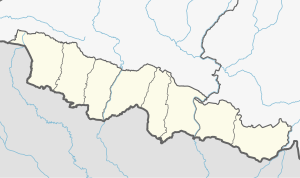
Back राजविराज नगरपालिका AWA राजबिराज Bihari Rājbirāj CEB Rajbiraj German राजविराज नगरपालिका DTY Rajbiraj Basque Rajbiraj Finnish Rajbiraj French राजविराज Hindi Rajbiraj Italian
Rajbiraj
राजविराज | |
|---|---|
| Rajbiraj Municipality | |
|
Clockwise from top Gajendra Chowk formerly Tribhuwan Chowk, Krishna Temple, Rajdevi Temple, Bhagwati Temple and Neta Chowk/Dashan Chowk/Ghantaghar | |
| Motto(s): "Rajbiraj city, prosperous green city"[1] | |
| Coordinates: 26°32′26″N 86°44′55″E / 26.54056°N 86.74861°E | |
| Country | Nepal |
| Province | Madhesh |
| Region | Mithila |
| District | Saptari |
| No. of wards | 16 |
| Named for | Rajdevi Temple |
| Government | |
| • Acting Mayor | Ishrat Praveen (PSP-N) |
| • MP | CK Raut (Janamat Party) |
| Area | |
| • Total | 55.64 km2 (21.48 sq mi) |
| Elevation | 76 m (249 ft) |
| Population (2017 est.) | |
| • Total | 69,803[2] |
| Demonym | Rajbirajian |
| Time zone | UTC+5:45 (NST) |
| Postal code | 56400 |
| Area code | 031 |
| Literacy rate | 79.71% |
| Website | www |
Rajbiraj (Nepali: राजविराज) is a mid-sized municipality located in the south-eastern part of Madhesh Province of Nepal. The city is also called the "Pink City of Nepal" because the township was designed in 1938 based on influence from the "Indian Pink City" Jaipur - thus making it the first township in Nepal to receive urban planning.[3] Rajbiraj is the district headquarters of Saptari which is transferred from old district headquarter Hanumannagar in 1944 and is the eighth largest city in the province.[4][5] It was declared a municipality in 1959.[6] According to the 2011 census, the city had a population of 37,738[7] but the latest population is estimated to be 69,803[8] making it the 33rd largest municipality in Nepal. The city area is spread over 55.64 km2 (21.48 sq mi) and comprises 16 wards.
The city is named after the ancient temple of Rajdevi, rebuilt by the Sena kings in the early 14th century.[9][10][11] Rajbiraj has prominently served as a politically active town in the modern history of Nepal and has been the hometown to a number of icons of the nation. Rajbiraj comes under the Saptari 2(B) assembly constituency which elects a member to the Provincial Assembly of Madhesh Province once every five years and it is a part of the Saptari 2 constituency which elects its MP once in five years.
Roadways are the major mode of transportation to the town but it also has air connectivity. The major trade routes to the town are offered by the Nepalese metropolis of Biratnagar situated 78 km (48 mi) east to the city as well as the Indo-Nepal border of Kunauli situated 10 km (6.2 mi) south to the city.[12]
- ^ Rajbiraj Municipality official website
- ^ "National Population and Housing Census 2011" (PDF). National Planning Commission Secretariat, Central Bureau of Statistics (CBS), Government of Nepal. November 2012.
- ^ Cite error: The named reference
Rajbirajwas invoked but never defined (see the help page). - ^ "Terms of Reference for the preparation of IUDP of municipality" (PDF). Government of Nepal. MOFALD. Retrieved 30 November 2023.
- ^ Jha, Ajay Kumar. "हनुमाननगरका मूर्तिहरू घर फर्किन्छन् !". Onlinekhabar (in Nepali). Retrieved 5 February 2018.
- ^ "Rapid urbanization in Nepal". www.housingnepal.com. Retrieved 8 May 2018.
- ^ "District Profile Saptari.pdf 1.8.3 जनसांख्यिक परिवर्तन" (PDF). cbs.gov.np. CBS. Retrieved 22 December 2020.
- ^ "स्थानिय तह". 103.69.124.141. Retrieved 8 May 2018.
- ^ Dāsa, Harikāntalāla (2003). Saptarī Jillākā pramukha sāṃskr̥tika sthalaharu : eka adhyayana : laghuanusandhānakārya (1. saṃskaraṇa. ed.). Kāṭhamāḍauṃ: Nepāla Rājakīya Prajñā-Pratishṭhāna. p. 120. ISBN 9789993350569.
- ^ "Sanjib Chaudhary: The ruins of Sen palace and temple in Saptari district of Nepal". www.asianart.com. Retrieved 8 May 2018.
- ^ Das, Basudevlal (2014). "The Sena Dyansty:From Bengal to Nepal". Academic Voices: 6.
{{cite journal}}: Cite journal requires|journal=(help) - ^ Pyakurel, Uddab P. (20 December 2015). Nepal - India Open Borders: Problems and Prospects. Vij Books India Pvt Ltd. ISBN 978-93-84464-92-9.
© MMXXIII Rich X Search. We shall prevail. All rights reserved. Rich X Search







